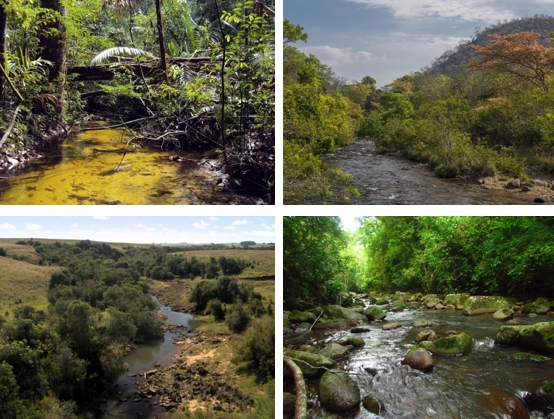


Fifty researchers at 26 institutions analyzed a huge mass of data, finding that no single size of conservation area is valid for the entire country (streams representative of the four biomes covered by the study: (clockwise) Amazon Rainforest, Cerrado, Pampa, Atlantic Rainforest; photos: Renato T. Martins, Frederico Salles, Fernando G. Becker, Carina Vogel)
Published on 03/15/2021
By José Tadeu Arantes | Agência FAPESP – Urbanization, livestock raising, and large-scale farming can lead to a collapse of aquatic ecosystems, endangering biodiversity and water and food supply. These occurrences are set to become increasingly frequent in the context of global climate change.
Several countries have opted for a strategy of protecting areas of native vegetation on the banks of rivers, streams, and lakes. In Brazil, the law requires the preservation of Permanent Protection Areas (APPs) on both public and private property. The size of these APPs varies according to the size of the water body involved.
There are uncertainties as to how to make this strategy effective and efficient, however. How much should be protected to prevent collapse? Is there a single size that is valid for all large regions? The article “Thresholds of freshwater biodiversity in response to riparian vegetation loss in the Neotropical region”, published in the Journal of Applied Ecology, sets out to answer this and other questions.
“We already knew that protecting riparian vegetation [adjacent to water bodies] is key to the maintenance of healthy freshwater ecosystems. The main question we set out to answer in this study was whether there are consistent patterns of reserve area sizes that are valid for different locales or regions,” said Renato Dala-Corte, a postdoctoral fellow at the Federal University of Goiás and first author of the article.
The study was the largest and most complete of its kind conducted in Brazil to date. It used data collected over years of fieldwork by 50 researchers affiliated with 26 research institutions. It was supported by FAPESP via the project ScaleBio, led by Tadeu Siqueira, a professor at São Paulo State University’s Bioscience Institute (IB-UNESP) in Rio Claro and a co-author of the article, as well as several other related projects.
“We combined satellite images showing the size of riparian zones along rivers with biological indicators obtained in the field, to estimate points where biodiversity changes abruptly along a 0% to 100% native vegetation cover gradient,” Siqueira told Agência FAPESP. “The results were very clear. There’s no such thing as a single size of riparian buffer that can protect aquatic biodiversity against land use pressure. There’s no magic number for all biomes.”
This finding contradicts the legislation on APPs, which sets size requirements without taking regional differences and local forms of land use into account. “It would have been a surprise to us if we had found a relatively invariable size for the whole of Brazil, a country with so many different biomes,” Siqueira said.
“This suggests many of our aquatic ecosystems may be close to the thresholds that lead to major biodiversity losses, or may already have surpassed them. Our legislation is fairly good in some respects, but the study indicates that it can be improved.”
The study also pointed to an impact gradient that correlates with distance from the watercourse. In an area with a radius of 50 meters, the smallest spatial unit evaluated, losing only 6.5% of the native vegetation is sufficient to cause a sharp decline in many aquatic invertebrate communities. This loss (6.5%) is the average for Brazil. On the regional scale, even smaller amounts of degradation have a significant impact. In the Amazon, 2.9% is sufficient in some cases.
“The closer you get to a stream, the smaller the change that suffices to have a negative effect on aquatic biodiversity. In other words, land use intensification, which is inevitable, should be kept as far away as possible from watercourses if we want to conserve our biodiversity and continue benefiting from the services these ecosystems provide,” Siqueira said.
The article “Thresholds of freshwater biodiversity in response to riparian vegetation loss in the Neotropical region” by Renato B. Dala-Corte et al. is available at: besjournals.onlinelibrary.wiley.com/doi/abs/10.1111/1365-2664.13657.
Source: https://agencia.fapesp.br/35155